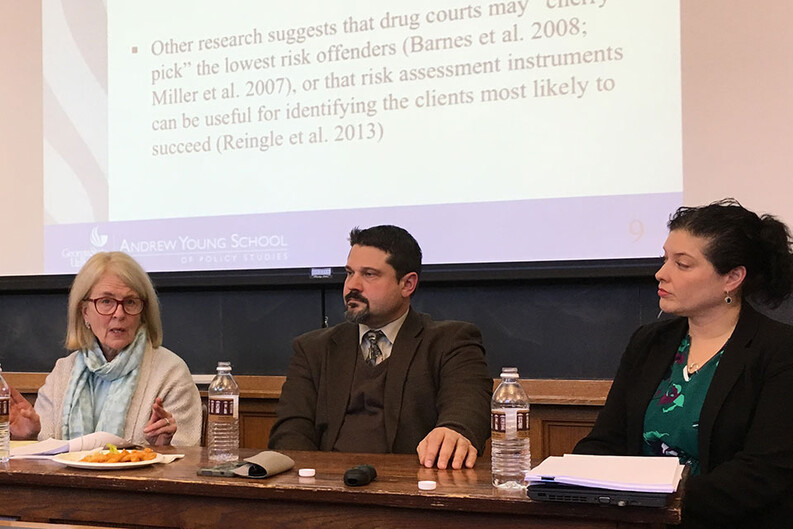Center Presents Panel on Drug Courts

On February 13, 2017, the Solomon Center, in partnership with the Yale Health Law & Policy Society, American Constitutional Society, and the Global Health Justice Partnership, brought together a panel that offered insights into the strengths and weaknesses of drug courts as an approach to treating addiction and reforming the criminal justice system.
According to Aaron Arnold, Director of the Drug Court Programs and Tribal Justice Exchange at the Center for Court Innovation, approximately 80% of arrested offenders have a history of addiction to drugs or alcohol. The first drug courts were developed in the late 1980s and early 1990s with a goal of combining assistance and accountability to break cycles of addiction and offending. Around 3,000 now operate across the country.
The panel largely agreed that there is convincing evidence that well-implemented drug courts (and they all emphasized the crucial importance of drug courts following best practices) can reduce recidivism. Eric Sevigny, Associate Professor of Criminal Justice and Criminology at the Georgia State University Andrew Young School of Policy Studies, said that research shows around a 12% reduction in future offending, a reduction that lasts over time. Judge Janet Bond Arterton, who is responsible for the implementation of Support Court (which is similar to a drug court in many ways) in the federal district of Connecticut, spoke movingly of the personal transformations she has witnessed in the participants she has worked with during the last six years.
On the other hand, panelists raised a number of concerns about how many drug courts operate and about the larger role of drug courts in a country that overinvests in the criminal justice system and underinvests in the mental health system. Denise Tomasini-Joshi, Deputy Director for International Harm Reduction Development at Open Society Foundations, was particularly concerned about the way in which drug courts in many communities monopolize most or all of the limited addiction treatment slots. Individuals seeking help for addiction find that they cannot get into treatment—unless they are arrested and prosecuted through drug court. Drug courts do not, however, expunge criminal records or otherwise mitigate the harmful effects of a conviction, and a criminal record is a high price to pay for getting help. Tomasini-Joshi and Sevigny both spoke of the importance of investing not just in drug courts but in a continuum of diversion programs, including pre-arrest diversion programs, particularly for first-time and low-level offenders. In theory, they argued, drug courts should focus only on high-need offenders, for whom the risks and services are more proportionate. All agreed, however, that too many drug courts instead focus on low-level offenders. There was also full agreement that more investment is needed in addiction treatment services.
Of particular interest to the health law community is the ongoing battle in the drug court field over medication-assisted treatment. In the past, many drug court judges have opposed medication-assisted treatment (e.g., methadone) out of a belief that abstinence is the only effective long-term solution to addiction. Tomasini-Joshi reported cases of judges ordering drug court participants to stop their medically prescribed treatment or face being returned to prison. Unsurprisingly, this has resulted in tragic deaths in some cases. The National Association of Drug Courts (NADC) now calls for all drug courts to recognize and support medication assisted treatment. Arnold is working with several states that are moving toward certifying drug courts as a way of imposing quality controls, and support for prescribed medication assisted treatment would be part of those certification standards. As the drug court field is largely still unregulated, however, and the NADC standards non-binding, it seems probable that issues remain in some courts.
Concerns were also raised that drug courts may actually increase time served for many offenders, particularly low-level offenders. Drug courts have the ability to return offenders to prison if they fail random drug tests or otherwise break the rules of the program. Some judges use that sanction quite heavily, often with only a single warning. Sevigny’s research has found that drug courts reduce the incidence of incarceration, but not the aggregate days of incarceration—in other words drug courts result in fewer people serving more days in prison. Judge Arterton related her own positive experience using a much more graduated set of sanctions. Sanctions for minor or early failures might include community service hours or a report to the group on a relevant book. The emphasis is on the participants’ agency in facing their disease. Her experience seemed to confirm Arnold’s opening argument that drug courts need to follow best practices to have positive outcomes for most people, and that those that do not can end up being more damaging than the system they were designed to fix.


